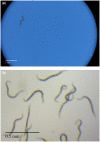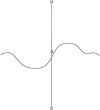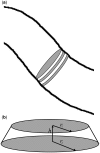A new method for measuring the size of nematodes using image processing
- PMID: 32161812
- PMCID: PMC6994075
- DOI: 10.1093/biomethods/bpz020
A new method for measuring the size of nematodes using image processing
Abstract
Many studies have been made on nematodes, especially Caenorhabditis Elegans, which are used as a model organism. In many studies, the size of the nematode is important. This article describes a method of measuring the length, volume and surface area of nematodes from photographs. The method uses the imaging software ImageJ, which is in the public domain. Two macros are described. The first converts the images into binary form, and the second uses several built-in functions to measure the length of the worm and its diameter along its length. If it is assumed that the worm has a circular cross-section, then the volume and surface area of the nematode can be calculated. This is a cheap and easy technique.
Keywords: nematode; image processing; size.
© The Author(s) 2020. Published by Oxford University Press.
Figures










Similar articles
-
NemaCount: quantification of nematode chemotaxis behavior in a browser.Invert Neurosci. 2016 Jun;16(2):5. doi: 10.1007/s10158-016-0188-1. Epub 2016 May 21. Invert Neurosci. 2016. PMID: 27209025
-
An automated system for measuring parameters of nematode sinusoidal movement.BMC Genet. 2005 Feb 7;6:5. doi: 10.1186/1471-2156-6-5. BMC Genet. 2005. PMID: 15698479 Free PMC article.
-
Versatile size-dependent sorting of C. elegans nematodes and embryos using a tunable microfluidic filter structure.Lab Chip. 2016 Feb 7;16(3):574-85. doi: 10.1039/c5lc01328c. Lab Chip. 2016. PMID: 26755420
-
The nematode Caenorhabditis elegans as a model to study viruses.Arch Virol. 2014 Nov;159(11):2843-51. doi: 10.1007/s00705-014-2168-2. Epub 2014 Jul 8. Arch Virol. 2014. PMID: 25000902 Review.
-
Caenorhabditis elegans: nature and nurture gift to nematode parasitologists.Parasitology. 2018 Jul;145(8):979-987. doi: 10.1017/S0031182017002165. Epub 2017 Dec 6. Parasitology. 2018. PMID: 29208057 Review.
Cited by
-
Natural variation in protein kinase D modifies alcohol sensitivity in Caenorhabditis elegans.bioRxiv [Preprint]. 2024 Jun 9:2024.06.09.598102. doi: 10.1101/2024.06.09.598102. bioRxiv. 2024. PMID: 38895441 Free PMC article. Preprint.
-
Standardized methods for rearing a moth larva, Manduca sexta, in a laboratory setting.PLoS One. 2025 Apr 29;20(4):e0316776. doi: 10.1371/journal.pone.0316776. eCollection 2025. PLoS One. 2025. PMID: 40299873 Free PMC article.
-
Standardized methods for rearing a moth larva, Manduca sexta, in a laboratory setting.bioRxiv [Preprint]. 2024 Dec 21:2024.12.18.629232. doi: 10.1101/2024.12.18.629232. bioRxiv. 2024. Update in: PLoS One. 2025 Apr 29;20(4):e0316776. doi: 10.1371/journal.pone.0316776. PMID: 39763740 Free PMC article. Updated. Preprint.
References
LinkOut - more resources
Full Text Sources
